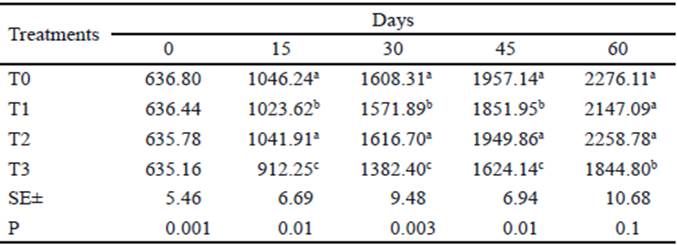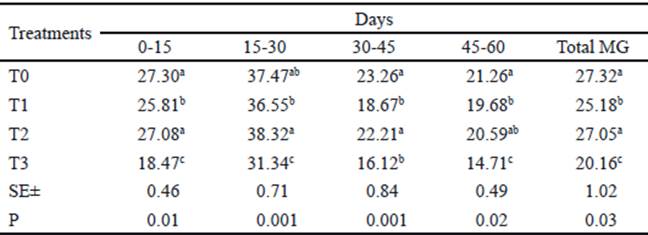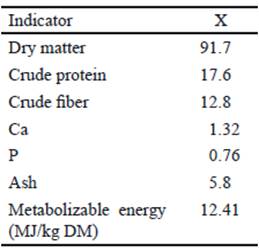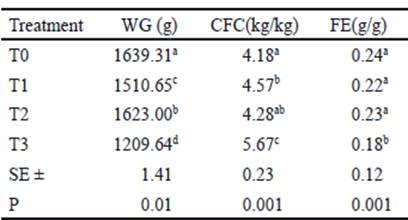INTRODUCTION
Plant productivity ifs determined by a group of factors inherent to plant and external factors. The first group includes their biological characteristics and the second is composed by soil, climate and management (Herrera et al. 2017). These aspects are particularly important nowadays, due to the high price of raw materials for the production of concentrated foods and fertilizers (Friedrich 2014).
The search for alternative foods for animal production, aimed at the use of available natural resources, is an important aspect to be taken into account nowadays (Arorav and Singh 2003) and establishes one of the greatest challenges in finding protein sources of easy acquisition, able to cover nutritional needs of non-ruminant species at low costs. Among the possible alternatives are the aquatic macrophytes such as Azolla, with promising results (Narayan 2011). In general, these plants are present in the tropics and can be useful for the development of appropriate and profitable systems from the environmental, economic and human point of view. In addition, the inclusion of this plant in the monogastric diet may have an important function, because it has between 17 and 18 % protein, low fiber content (34 % neutral detergent fiber - NDF) and around 90 % of dry matter digestibility (Buenaño et al. 2018).
On the other hand, rabbit production constitutes an important alternative for obtaining protein for human consumption, due to its high prolificacy, low generational interval and high meat yield, with low cholesterol content (Petracci and Cavani 2013). However, rabbit feeding faces several problems, among which the low availability of cheap inputs, as well as the high cost of commercial concentrated foods, which encourages the search for strategies based on the use of unconventional raw materials (Silva 2016). Therefore, the objective of this study was to determine the chemical composition of Azolla filiculoides meal and to evaluate productive indicators in rabbits, by replacing part of the commercial concentrate with this plant in the diet.
MATERIALS AND METHODS
Location of the study area. The experiment was carried out between February and July, in Río Cauto municipality, Granma province, Cuba.
Cultivation of the Azolla and meal production (HA). For the production of Azolla, two pools, each with 7 m wide, 10 m long and 1.30 m deep, were installed and represented a total area of 140 m2. In each pool, 200 g/m2 of Arzolla fresh material were planted and 65 kg of cow manure was deposited in different parts of each deposit. The harvest was manually carried out, with intervals of 7 days, once it was found that the entire surface of the pond was covered by a green biomass, characteristic of the cultivated species (Méndez et al. 2018a).
A 75 % of the plants was harvested and dried in the sun for 72 hours on polyethylene blankets, with a total surface area of 16 m2 for drying. Around 6 or 7 flips were made from 7:00 a.m. up to 7:00 p.m. They were crushed using a hammer mill with 0.8 cm screen. The obtained material was packed in polyethylene bags and stored in a room at room temperature.
Commercial concentrate (CC). This was acquired in Fábrica de Piensos de Bayamo (certified), through the Empresa de Ganado Menor (EGAME, initials in Spanish) formulated for the feeding of rabbits and its chemical composition appears in table 1.
Experimental procedure. Forty eight Pardo cubano weaned male animals from Pardo cubano breed were selected. These animals were clinically healthy, with 38 ± 3 days of age and average initial weight of 646.6 ± 9.5g, and underwent 15 days of adaptation to the feeding change to avoid alterations due to stress they may suffer in this first stage. The experiment lasted 60 days.
Treatments and experimental design. Nutrient balance of each treatment was carried out for the substitution of different levels of the commercial concentrate (0, 8, 12 and 18 %) for Azolla filiculoides meal. A completely randomized design was used, divided into four groups, with three replicates each and four animals as experimental units. Treatments were: T0, 100 % commercial concentrate; T1, 94 % of commercial concentrate and 6 of Azolla meal (94 % CC + 6 HA); T2, 88 % of commercial concentrate and 12 of Azolla meal (88 % CC + 12 HA) and T3, 82 % of commercial concentrate and 18 of Azolla meal (82 % CC + 18 HA).
Food management. Food supply was performed twice a day (8:30 a.m. and 5:00 p.m.). To this end, circular clay feeders with a diameter of 15 cm and a height of 7 cm were used. Calculations were made weekly to adjust food intake (HA and CC) in correspondence with 9 % of the live weight (Maertens and Villamide 1998), also complying with the intake regulations described by NRC (1990) (table 2).
Water was offered ad libitum, using circular clay containers with a dimension of 16 cm of inferior diameter, 13 cm of superior and 7 cm in height, with a capacity to store a volume of liquid equal to 800 mL ± 200. They were daily washed and placed in the sun every two days to avoid pathogen proliferation.
Variables evaluated for Azolla meal. Dry matter (DM), crude protein (CP), fiber (CF), ether extract (EE), ash, nitrogen-free extract (NFE), Ca and P were determined, according to AOAC (2016), and metabolizable energy estimated regarding NRC (1990). In addition, amino acids like threonine, valine, methionine, isoleucine, leucine, lysine, histidine, arginine and tryptophan were quantified (Dewanji 1993). Each sample was analyzed in triplicate.
Indicators evaluated in animals. The experimental phase was 60 days long and the initial, partial and final live weight, average daily gain and food conversion were determined. The weighing of animals (0,15, 30, 45 and 60 days) and of food was carried out from 8:00 am to 9:00 am, in scales with precision of 0.1 g. The productive indicators for this category were individually measured.
Mean gain was calculated by the difference between the final weight (FW) and the initial weight (IW) divided by the time according to: MG = (FW - IW)/time The increase in daily weight was established by the formula: DWI = FW - IW
Food intake (FI) was calculated by the difference of the offer minus the rejection, weighed twice a day (7:00 am and 4:00 pm) according to: FI = Food supplied - Food rejected
Food efficiency (FE) referred to weight gain in relation to food consumed according to: FE = Weight gained/Intake.
Food conversion factor (FCF) was referred to as the food consumed in relation to weight gain, by: FCF = Food consumed / Weight gain
Statistical analysis. Data was processed by simple classification variance analysis with a significance level of p <0.05. Kolmogorov-Smirnov test (Massey 1951) was used to verify data normality and the homogeneity of variances was determined by Bartlett (Bartlett 1937) test. The multiple comparison of adjusted means was performed by Duncan (1955) test.
RESULTS
Results of the chemical composition of Azolla meal (table 3) showed high DM values, a component that guarantees that this plant in the form of meal can be conserved and stored for feeding rabbits. On the other hand, high CP content appears, with the presence of important amino acids for the species, as well as values of metabolizable energy and crude fiber.
The plant presented a good balance of essential amino acids, of great importance for the development and growth of the species under study, as well as coming from a cheaper source than the commercial concentrate.
Intake of dry matter and nutrients (CP, ME) showed differences among the evaluated treatments (table 4) for the concentrate and for the HA. For the specific case of DM, the highest intakes appear for treatments T1 and T2, without differences between them and with the rest. However, the highest intake for HA was shown by T3, where the highest inclusion percentage appears. For total CP intake, the highest value was presented by control treatment, with significant differences with respect to the rest. Similar performance appears when evaluating only the concentrate. For the specific case of HA, the highest value appears for T3. When evaluating DM intake, similar results to those of crude protein were shown.
Table 4 Intake of dry matter and nutrients (CP and ME) of commercial concentration (CC) and HA.

abcd Different letters in the same column indicate significant differences for (p< 0.05) according to Duncan (1955)
In weight increase as the experiment progressed, it could be seen (table 5) that the initial weights showed no differences among them. However, after 15 days, the best results were presented by control and T2 treatment, with significant differences with respect to the other two. This performance was repeated at 30 and 45 days. When the final days of research were reached, substitution levels 0, 6 and 12 showed no differences among them, being T3 the one with the lowest value. The lowest weight of animals was always obtained in the treatment that consumed the highest amount of Azolla meal.
Table 5 Performance of live weight (g) per treatments during 60 days of experiment

abcDifferent letters in the same column indicate significant differences for (p< 0.05) according to Duncan (1955)
Daily mean gain (DMG) showed its best results in the first 15 days of observation for control and T2 treatments. For the second evaluated stage, there were no differences between the zero level of inclusion and 12 % of HA. When evaluating the third stage, T0 and T2 treatments did not differ between them and, at 45-60 days, T0 and T3 treatments did not show significant differences between them. Throughout the studied stage, the highest percentage of the highest HA inclusion (T3) presented the lowest gains (table 6).
Table 6 Performance of daily mean gain (g) per treatments

abcDifferent letters in the same column indicate significant differences for (p< 0.05) according to Duncan (1955)
The increase of total weight (WG) at the end of the experiment showed the best results for control and T2 treatments, and the lowest for T3. For food conversion (FC), the aforementioned treatments showed no differences among them, while food efficiency (FE) showed the best results for the first three treatments, without significant differences among them. For the three evaluated variables, the lowest results were obtained in the treatment T3 with the highest HA content (table 7).
DISCUSSION
The peculiarities of the digestive system of rabbits allow the use of food that, for other non-ruminant species, generate low productivity, as this species achieves profitable use of fibrous sources in the diet (Nieves et al. 2009b), due to fermentation in the caecum. In addition, the process of cecotrophy maximizes the use of food (Nieves et al. 2009a). This research showed that Azolla meal, with a dry matter superior to 90 %, is a suitable food for rabbits, starting from its specific characteristics, fundamentally by fiber percentage, since this produces increase in the intake, to maintain the digestible energy intake (Caro and Dihigo 2012).
On the other hand, CP value was higher than 20 %, and fiber reached 29 %. It is important to note that Azolla is characterized by its richness in protein and ash, so it should be expected to be rich in fiber fractions, although it is not considered that the cell wall is lignified in the same way as in terrestrial plants, where it is necessary to have rigid support structures (Méndez et al. 2018a).
Other results in the consulted literature refer to values similar to those in this research, when Azolla plant was studied as an alternative feed for aquaculture (Méndez et al. 2018a). These authors reported 22 % content for this nutrient and noted that this value is in the range referred for this plant (Parashuramulu et al. 2013 and Bhaskaran and Kannapan 2015). These high CP contents are favored by plant mechanisms for fixing nitrogen and later include it into its biomass (Lumpkin and Plucknett 1982).
The contents of calcium and phosphorus are similar to those reported by Méndez et al. (2018a) when evaluating the Azolla plant as an alternative food for monogastric animals. These authors found values of 4.59 and 0.56 % for Ca and P, respectively, stating that the low phosphorus content found in this species explains the importance of supplementation with this element for an adequate plant growth (De Waha et al. 2001).
On the other hand, the results of the present study showed adequate contents of different amino acids, ratifying what was reported by Becerra et al. (1990) and Leng et al. (1995), by pointing out that Azolla has an appropriate amino acid balance, which facilitates its use for feeding fish, crustaceans and other species. Other studies reported the importance of amino acids for monogastric species, highlighting that methionine and lysine concentration in the ration should be adequate, since they intervene in the animal development, and, specifically, methionine below 14 %, can be the cause of growth delay (Gaber 2006 and Ngugi et al. 2017).
It is important to highlight that protein level of the plant under study is high, and a good quality in terms of amino acids, essential compounds in the monogastric diet. This is explained by the fact that this plant is mainly composed of metabolically active material, since it does not need to develop structural and support material (Adelakun et al. 2016).
Azolla is one of the most used aquatic plants for animal feeding. Different studies demonstrate the use of Azolla in animal rations, notifying that it decreases diet costs up to 40 % (Méndez et al. 2018a). Other studies mention that the inclusion of Azolla as a food in the diet reduces the cost of the ration by 25% without affecting the yield of species such as pigs, fish, birds and rabbits (Gangadhar et al. 2015 and Kollah et al. 2015), which justifies this research.
Results of this research, when evaluating productive indicators of Oryctolagus cuniculus species for 60 days, showed intake of DM, CP, and ME of Azolla, different in all the evaluated treatments, due, among other aspects, to the percentage of inclusion of CC and HA in the ration. Results in different monogastric species refer to favorable intake of this plant (Becerra et al. 1990). These authors express that there is no disadvantage in behavioral traits when the animals are supplied with up to a third of the diet in the form of Azolla, and more importantly, prepared in different ways. This may explain what happened in this study.
For CP and ME, there are differences in their intake, because the percentages of HA inclusion are different in the evaluated treatments. It should be noted that the contributions of CP by Azolla are high, starting from its chemical composition, where it reaches up to 20, 74 by 17.6 of CC, in addition to protein quality, factors that influence the intakes of these nutrients (Ponce de León 2003). To this is added that this plant maintains a symbiotic relationship with the cyanobacteria. This fact makes the Azolla tend to contain relatively high levels of N and be an attractive protein source for animal feed, not only for cattle and poultry, but also for other species (Ponce and Fitz 2004 and Méndez et al. 2018b).
When 12 % of HA was included in the diet, the weights were increased to 2,258.78g at 60 days, without differences with the control (table 5), which could be attributed, among other aspects, to the percentages of protein in the diet. Studies conducted in Cuba reported similar values to include Agave tequilana in the diet (Isert et al. 2016), referring that when these animals are fed with vegetable meals, they do not present digestive problems and productive indicators are increased (García et al. 2012). Daily mean gains obtained in this research (table 6) are higher than those reported by other authors, by substituting up to 20 % of the commercial concentrate for legume meal (Caro and Dihigo 2012) and by using s ugarcane in the ration (Vázquez et al. 2016).
Another study reflected daily mean gains below those shown in this study (Ayorinde and Oluwatosin 2012). These authors found values close to 13 g, with the inclusion of forage diet ad libitum and restriction of the commercial concentrate. However, the CP and CF values of the diet were lower than those of this study, which could influence the results. This confirms the findings of Caro and Dihigo (2012), who stated that animal response can be affected by multiple factors. Therefore, animal growth can be influenced by diet quality, environmental conditions and aspects inherent in genetics.
It is important to note that, for the DMG, there are no differences between CC and 12 % of HA inclusion. This could be related to the composition of the diet for these treatments, as well as quality. In the increase of total weight per treatment (table 7), it was possible to appreciate the differences of T0 and T2 with respect to the other treatments, which could be due to a better use of the diet, because of its composition (Macías and Usca 2017).
Food conversion is a practical measure to estimate efficiency with which animals use the ingested food for growth purposes (Caro and Dihigo 2012). In this study, food conversion demonstrated that the inclusion of 12 % of Azolla meal (table 7) did not decrease this indicator with respect to the control, determined, among other aspects, by intake and weight gain in this treatment. Results of Núñez et al. (2017) are inferior to those of this research, who reported values between 7 and 8 for rabbits of this category when using oat in the diet, which could influence these results.
Azolla meal has a suitable chemical composition to be used in the feeding of rabbits. The inclusion of up to 12 % of this meal in the ration for rabbits did not affect the evaluated productive indicators. Studies are needed to evaluate economic indicators and meat quality when using the inclusion of HA in the diet.











 texto en
texto en 






